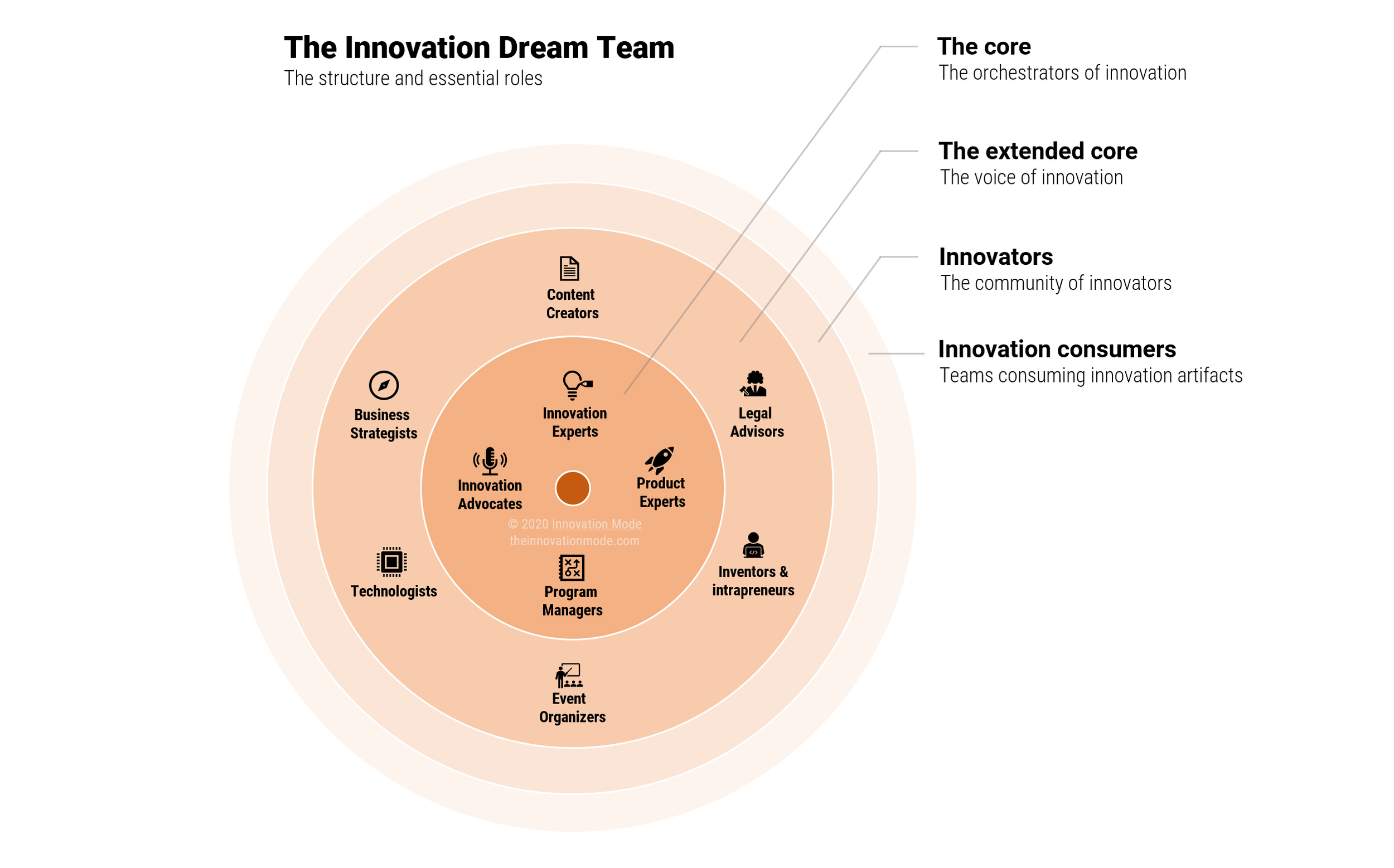How to Set up the Innovation ‘Dream Team’
A talented, cross-disciplinary team with a special mission: to make the company truly innovative.
To make your company truly innovative, you need to establish a special culture, and a new mindset across all levels, disciplines, and functions. You need a framework providing the right methods, processes, and tools.
As a leader, you need to introduce and promote a solid innovation framework, that gradually becomes part of the normal, day-to-day business
But, to get there, you will have to go through a challenging transformation phase, which is expected to have a significant impact on your company. This journey requires strong leadership by a talented, ‘Innovation Dream Team’ — a unique synthesis of strategists, technologists, and communicators — to lead this fundamental change and move the company towards a mode of innovation. This is the team that introduces a new culture, inspires people and leads innovation by example.
→ Check also: the role of the Chief Innovation Officer, defined.
The Responsibilities of the ‘Dream Team’
The objectives and specific roles of the ‘innovation dream team’ depend on the type, size, and industry of the company. In the typical case, companies need a driving force from within — a solid team that naturally diffuses the innovation thinking and introduces the right technologies and best practices regarding innovation and creative thinking. The Dream Team ensures that the overall innovation program is in alignment with the strategy of the organization and in harmony with the ongoing business; it manages the noise and the risk of (internal) disruption coming from ambitious innovation activities and programs.
The ‘Dream Team’ of innovation must be strategic, tactical, agile and fast
Depending on the innovation readiness of the company, the responsibility areas of the ‘Dream Team’ may include the following:
1. Set the innovation strategy, define success
A clear strategy and a roadmap towards the desired innovation-driven mode are critical. The ‘innovation team’ needs to define what innovation is in the context of the company, and how to ‘get there’. It must identify the milestones and define the metrics and success criteria across the innovation transformation journey.
To properly set the innovation strategy, the team must demonstrate a deep understanding of the current state of the company, the challenges, and be able to spot the business opportunities. The dream team must be capable of capturing and interpreting market and competition insights, trends, and predictions; they must clearly articulate and communicate the vision of the company and the master plan that will transform it into an innovation-driven organization.
2. Provide a framework for innovation
The ‘dream team’ must identify and provide the right enabling technologies to facilitate day-to-day innovation activities and also to speed up the adoption of the innovation culture. For instance, the team needs to select, adapt, and provide ideation, innovation management, and brainstorming tools, platforms to set up innovation challenges like hackathons, ideas management pipelines, information-sharing applications, etc.
3. Innovate by example
Innovation is an exciting and inspiring topic, but if you don’t deliver concrete examples of applied innovation — ideally through success stories — its power will quickly fade out.
The ‘innovation dream team’ must have creative members, engineers, and technologists to showcase real innovation, at pace; the team needs to clearly connect the theoretical, abstract notions of innovation with the commercial context of your company; it must demonstrate how innovation can bring concrete commercial results, fast. This is the best way to inspire people and drive high levels of engagement with the overall innovation initiative.
4. Communicate, Inspire, Diffuse
Communication in this context is critical: no matter how innovative your team or how efficient the innovation framework is, if the communication is not effective, the innovation initiative is at risk. Proper communication is the way to spread the innovation message and inspire people to join the ‘new way of working’; to prove that innovation creates value for the company, the employees, the customers, and possibly for the society; to diffuse great ideas and change how products are conceived, designed and built.
5. Measure Innovation, drive improvement
The ‘innovation team’ needs to systematically measure and evaluate the progress towards each next milestone of the innovation transformation program. In case of gaps or ‘surprises’, the team needs to quickly review the assumptions, the involved models and processes, and make the right decisions in an agile manner- to ensure alignment with the overall strategic innovation plan.
6. Handle the noise and avoid disruption
Innovation can generate noise and become disruptive (not to the market, but ironically, to the company). The ‘innovation dream team’ must prevent the situation where the standard KPIs of the company are exposed to risk due to aggressive, over-ambitious innovation programs or, for example, due to unexpected response to a ‘call to innovate’. The team must handle the noise and be very effective in identifying the signals, that is, the real business opportunities. It must be able to prioritize wisely and communicate in a smooth and effective way.
The Synthesis of the ‘Innovation Dream Team’
The size and exact synthesis of the team heavily depend on the industry, the domain of expertise, and the size of the corporation. In any case, the ‘Innovation Team’ needs to be multidisciplinary with the right balance of strategy, execution, and communication experts. In the typical case, the Innovation Team is led by a senior Innovation/Product Leader or the Chief Innovation Officer and has most of the following profiles:
Strategists
Planning the innovation transformation journey requires strategic thinking. You need strategists with extensive exposure to innovation programs and a deep understanding of your industry, the competitors, the market dynamics, and the state of the art in reference to your domain.
Product experts
The Innovation transformation program must be supported by well-defined problems worth solving, business opportunities, innovation themes, and focus areas. The dream team must be able to ‘think of products’ and spot related opportunities in the market - coming from the rapidly changing consumer demand patterns. The team must develop a deep understanding of the competition and the global developments - to identify gaps, overlaps, and opportunities that link up to commercial aspects of your business. The team must think as a user and identify how innovation can bring value impact.
Technologists
These are experts combining deep technical knowledge, best practices, and understanding of product architecture, the product development lifecycle, and product innovation methodologies. They drive initiatives such as the transition to agile engineering practices and modern product development techniques with a focus on experimentation and data-driven decision-making. In a software context, these could be Senior Architects or Engineers with extensive prototyping and/or agile product development experience.
Program Managers
Program managers are senior members specialized in ‘making things happen’ - they drive programs, lead multiple initiatives, and manage projects to enable the innovation transformation.
IP experts
Even if intellectual property is not part of your objectives, great opportunities might appear — ones that you cannot afford to miss: as teams ideate, collaborate, and experiment with ideas, they might produce novel, high-potential and patentable solutions. The team needs good reflexes in spotting patentability and potential competitive advantages.
True Innovators
The ultimate objective of the ‘innovation transformation program’, is to change the typical employee into a real innovator, leading to an innovation-led organization that creates more value for customers and stakeholders through novel ideas. The best way to achieve this is by example: you will need to form a team of innovators to reset the baseline in terms of mentality, behavior, best practices, and most importantly, in terms of outcomes.
A multidisciplinary team able to experiment in a rapid mode - to define, build and validate prototypes in no time.
The dream team needs creative people, passionate about delivering novel solutions to challenging problems; risk-takers, self-starters, and ambitious professionals with both technical and commercial acumen.Innovation Advocates
To introduce and establish the innovation mindset, you need a clever and effective communication plan - one that presents the innovation program itself, along with the activities, outcomes, and especially the success stories of innovation. This effort must be led by passionate and effective communicators who are responsible for diffusing the innovation message, communicating progress, achievements, top performers, and innovation stories.
Innovation Specialists
These are the experts in innovation management, methodologies, and related tools. Their role is to educate the organization regarding experimentation, idea management, design thinking, agile frameworks, and related methodologies and practices. They typically facilitate and drive workshops, ideation sessions, and the practical aspects of day-to-day innovation.
Guest innovators
The dream team must be flexible enough to allow employees outside the core to join for a certain period of time, based on a rotation scheme. This increases the flow of information and expertise and ensures a smoother transition to the innovation-driven mode. It is a great way to minimize the risk of isolating the innovation team from the rest of the company.
The structure of the innovation team should be flexible and flat: there should be three lines of reference — the strategic, the practical innovation and the communication — all aligned but also with clear separation of concerns and well-defined, independent work streams and programs.
Risks
One of the major risks when having a separate ‘innovation team’, is the risk of isolation from the rest of the organization: Innovation teams usually have the benefit of using the latest technologies and safe experimentation/ development environments, without the production and operations-related constraints and challenges.
This can lead to a situation where the innovation team is seen, by the rest of the company, as a detached entity working in a sandbox, while all other teams are dealing with real-world business problems and challenges. This is why effective communication, continuous information sharing, innovation by example, and rotation schemes are very important when setting up this team.
Another major risk is to disrupt the day-to-day business: the entire system could easily become dysfunctional if employees lose focus and teams get distracted.
In another scenario, continuous ideation could generate noise and a long backlog of proposals, which cannot be effectively handled. Established product development processes could also be disrupted by random suggestions or not properly defined business proposals.
The innovation team must ensure the right balance between innovation and ‘business as usual’, by identifying the real business opportunities and setting the right focus.
→ Check also: our unique innovation advisory offering: Chief Innovation Officer On Demand program and the Innovation Toolkit - a collection of innovation templates that empower teams to frame problems, shape ideas, run hackathons, and more.
Cover image by RhondaK Native Florida Folk Artist - Unsplash




Digital Transformation – What is it all about? Erik Schumb, founder & CXO, Agile Sprints and one of the '60 Leaders on Innovation' shares his insights.